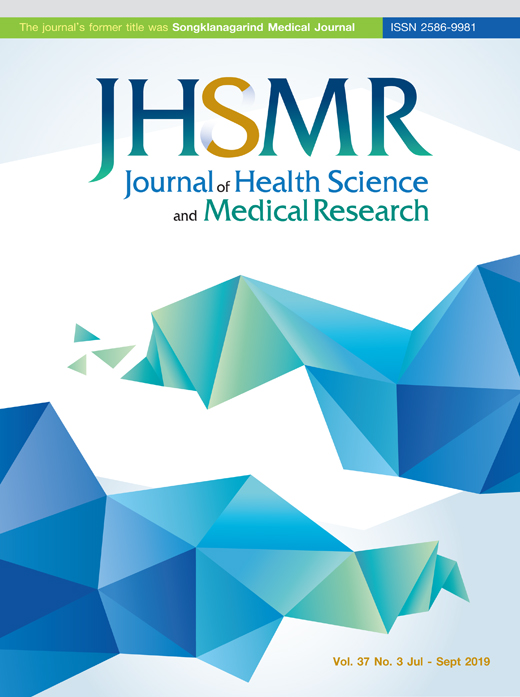Validation of Functional Assessment of Cancer Therapy with Nasopharyngeal Cancer Subscale (FACT-NP) for Quality of Life in Thai Patients
DOI:
https://doi.org/10.31584/jhsmr.201958Keywords:
FACT-NP, factor analysis, nasopharyngeal cancer, quality of lifeAbstract
Objective: To develop and validate the Thai version of the functional assessment of cancer therapy with nasopharyngeal cancer subscale (FACT-NP) with the abbreviated version of the World Health Organization Quality of Life-BREF instrument (WHOQOL-BREF).
Material and Methods: A cross-sectional study was performed in the Radiology Department between January 2014 and October 2016. Inclusion criteria: nasopharyngeal carcinoma patients aged greater than 18 years. Exclusion criteria: no comprehension of the Thai language, had other cancers (except for skin cancer and diagnosed with impaired cognition and/or overt psychosis), major depression or delirium. After signing the consent form, participants were interviewed and self-completed FACT-NP and WHOQOL-BREF. The structure of the FACT-NP was determined with exploratory factors analysis. The internal reliability of identified domains was evaluated using Cronbach’s alpha. The correlation between domains of the modified FACT-NP and the domains of WHOQOL-BREF were examined with Spearman’s correlation. Known-group validity was determined by comparing patients with different sociodemographic and clinical characteristics using the T-test, Ranksum test and analysis of variance. A p-value of less than 0.05 was considered significant.
Results: This study was terminated early due to a long accrual period. Of the 230 patients included in the study, only 220 completed both FACT-NP and WHOQOL-BREF. Exploratory factor analysis showed an accumulative variance of 0.56 with 4 factors. The internal reliability of modified FACT-NP was 0.92. There was moderate correlation between modified FACT-NP and WHOQOL-BREF. Both the modified FACT-NP and WHOQOL-BREF could identify differences between the groups.
Conclusion: The Thai modified FACT-NP was found to be both valid and reliable for measuring the quality of life in Thai nasopharyngeal cancer patients.
References
2. Yan M, Kumachev A, Siu LL, Chan KK. Chemoradiotherapy regimens for locoregionally advanced nasopharyngeal
carcinoma: a Bayesian network meta-analysis. Eur J Cancer 2015;51:1570–9.
3. Zhang L, Zhao C, Ghimire B, Hong MH, Liu Q, Zhang Y, et al. The role of concurrent chemoradiotherapy in the treatment of locoregionally advanced nasopharyngeal carcinoma among endemic population: a meta-analysis of the phase III randomized trials. BMC Cancer 2010;10:558.
4. National Comprehensive Cancer Network (NCCN). NCCN Clinical practical guidelines in oncology. Head and neck cancers (Version 2.2018) [homepage on the Internet]. Pennsylvania:NCCN; 2018 [cited 2018 Apr 14]. Available from: https://www.nccn.org/professionals/physician_gls/pdf/head-andneck.pdf
5. Du C, Ying HM, Kong FF, Zhai RP, Hu CS. Concurrent chemoradiotherapy was associated with a higher severe late toxicity rate in nasopharyngeal carcinoma patients compared with radiotherapy alone: a meta-analysis based on randomized controlled trials. Radiat Oncol 2015;10:70.
6. The Whoqol Group. The World Health Organization Quality of Life Assessment (WHOQOL): development and general
psychometric properties. Soc Sci Med 1998;46:1569–85.
7. Fayers PM, Machin D. Introduction. In: Fayers PM, Machin D. editors. Quality of life: the assessment, analysis, and interpretation of patient-reported outcomes. 2nd ed. West Susex:Wiley; 2007.
8. Singer S, Arraras JI, Chie WC, Fisher SE, Galalae R, Hammerlid E, et al. Performance of the EORTC questionnaire for the assessment of quality of life in head and neck cancer patients EORTC QLQ-H&N35: a methodological review. Qual Life Res 2013;22:1927–41.
9. Mahatnirunkul S, Pumpisanchai W, Tuntipivatanakul W. Comparison of the WHOQOL-100 and the WHOQOL-BREF (26 items). J Ment Health Thai 1998;5:4–15.
10. Phungrassami T, Katikarn R, Watanaarepornchai S, Sangtawan D. Quality of life assessment in radiotherapy patients by WHOQOL-BREF-THAI: a feasibility study. J Med Assoc Thai 2004;87:1459–65.
11. Anna BC, Jason WO. Best practices in exploratory factor analysis: four research & evaluation. PARE 2005;10:1-9
12. Ratanatharathorn V, Sirilerttrakul S, Jirajarus M, Silpakit C, Maneechavakajorn J, Sailamai P, et al. Quality of life, functional assessment of cancer therapy-general. J Med Assoc Thai 2001;84:1430–42.
13. Ding Y, Hu Y, Hallberg IR. Psychometric properties of the chinese version of the functional assessment of cancer therapy-cervix (FACT-Cx) measuring health-related quality of life. Health Qual Life Outcomes 2012;10:124.
14. Tong MC, Lo PS, Wong KH, Yeung RM, van Hasselt CA, Eremenco S, et al. Development and validation of the functional assessment of cancer therapy nasopharyngeal cancer subscale. Head Neck 2009;31:738–47.
15. Yu CL, Fielding R, Chan CL, Tse VK, Choi PH, Lau WH, et al. Measuring quality of life of Chinese cancer patients: a validation of the Chinese version of the Functional Assessment of Cancer Therapy-General (FACT-G) scale. Cancer 2000;88:1715–27.
16. Salas S, Baumstarck-Barrau K, Alfonsi M, Digue L, Bagarry D, Feham N, et al. Impact of the prophylactic gastrostomy for unresectable squamous cell head and neck carcinomas treated with radio-chemotherapy on quality of life: prospective randomized trial. Radiother Oncol 2009;93:503–9.
17. Silander E, Nyman J, Bove M, Johansson L, Larsson S, Hammerlid E. Impact of prophylactic percutaneous endoscopic gastrostomy on malnutrition and quality of life in patients with head and neck cancer: a randomized study. Head Neck 2012;34:1–9.
18. Huang TL, Chien CY, Tsai WL, Liao KC, Chou SY, Lin HC, et al. Long-term late toxicities and quality of life for survivors of nasopharyngeal carcinoma treated with intensity-modulated radiotherapy versus non-intensity-modulated
radiotherapy. Head Neck 2016;38(Suppl 1):E1026–32.
19. Lastrucci L, Bertocci S, Bini V, Borghesi S, De Majo R, Rampini A, et al. Late toxicity, evolving radiotherapy techniques, and quality of life in nasopharyngeal carcinoma. Radiol Med 2017;122:303–8.
20. Pan XB, Huang ST, Chen KH, Jiang YM, Ma JL, Qu S, et al. Intensity-modulated radiotherapy provides better quality of life than two-dimensional conventional radiotherapy for patients with stage II nasopharyngeal carcinoma. Oncotarget 2017;8:46211–8.
























